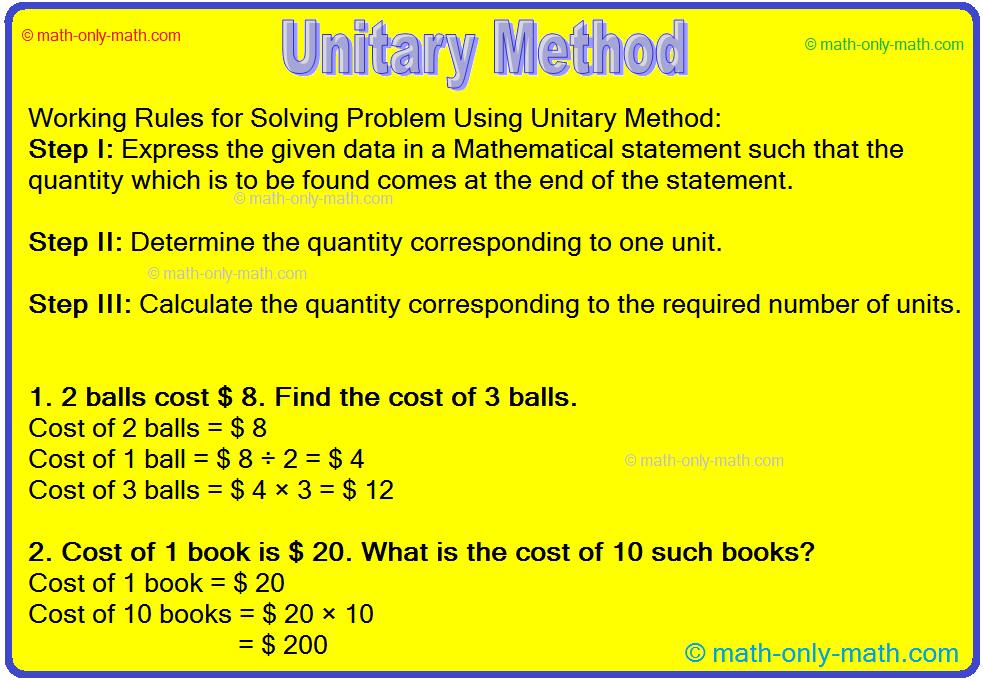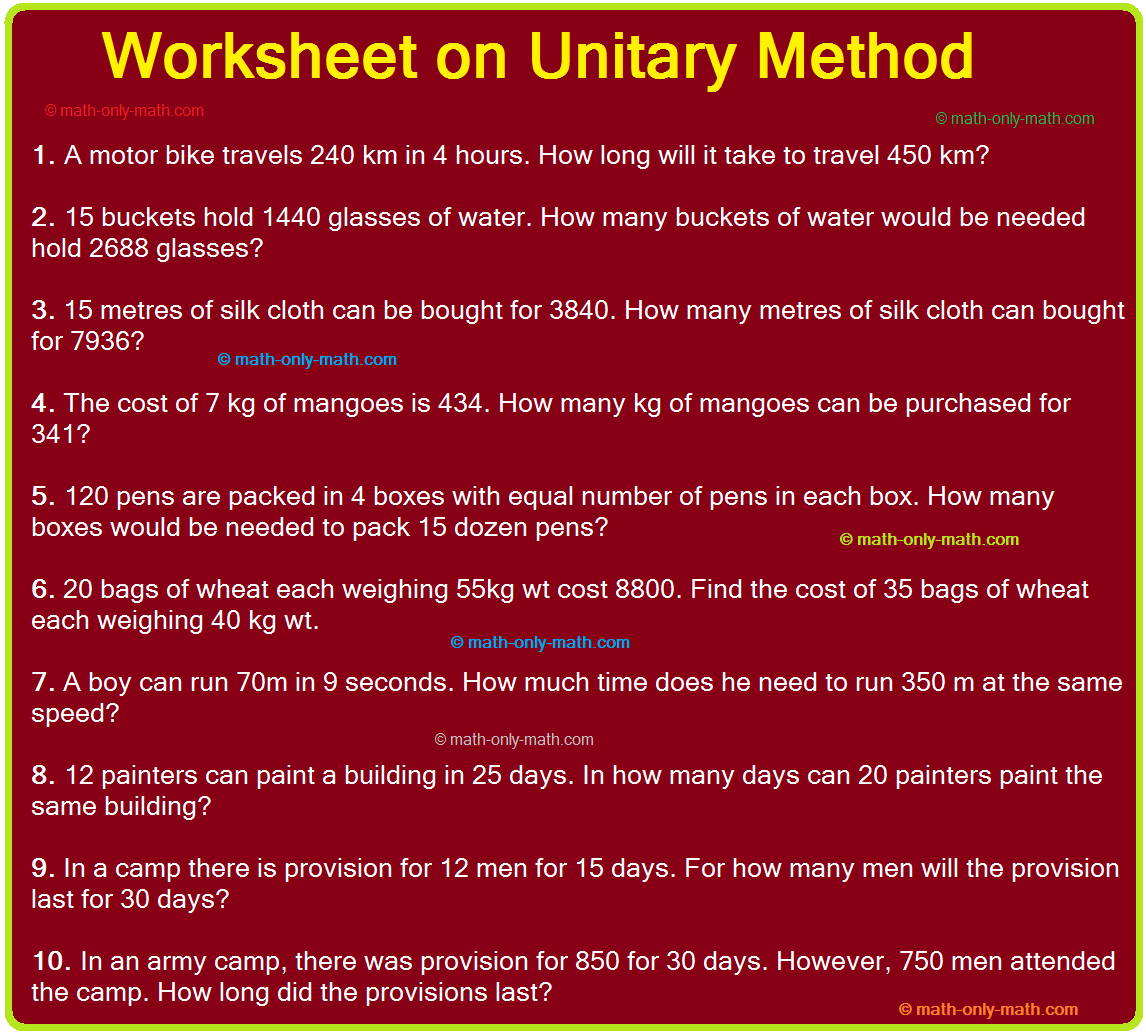Subscribe to our ▶️ YouTube channel 🔴 for the latest videos, updates, and tips.
Unitary Method
In unitary method we will learn how to find the value of a unit from the value of a multiple and the value of a multiple from the value of a unit.
When we go to the market to buy any article, we ask the shopkeeper to tell the price of the article. This is called unit price. We calculate the price of number of articles, we want to buy, with the help of this unit price. Sometimes, we calculate unit price when the price of a multiple is given. The method to calculate the price of the required articles is called unitary method.
Generally, first we find the value of one article from the value of a multiple and then we find the value of the desired number of articles from the value of one. Usually this method involves the operations of multiplication and division both.
The method to find out the value of one unit (item) which in turn used to find the value of required number of units is called an unitary method.
Working Rules for Solving Problem Using Unitary Method:
Step I: Express the given data in a Mathematical statement such that the quantity which is to be found comes at the end of the statement.
Step II: Determine the quantity corresponding to one unit.
Step III: Calculate the quantity corresponding to the required number of units.
Remember:
To find the cost of a number of articles ............
● We have to first find the cost of 1 article.
● Then we have to multiply the cost of 1 article with the number of articles required. This is called Unitary Method.
To find the cost of 1 article ............
● We have to divide the total cost by the number of articles purchased.
For example,
(i) A pack of 6 balls costs $ 48 and we have to buy 4 balls.
(ii) 20 oranges cost $ 60 and we have to buy 8 oranges.
(iii) The cost of 100 kg of wheat is $ 850 and we have to buy 40 kg of wheat.
In all such cases, first we find the unit cost for calculating the cost of the desired number of articles. To find the unit cost we divide the cost of many articles by the number of articles.
Ron wanted to buy 7 notebooks. The shopkeeper told him that the price of 1 notebook is 15 rupees. He thought for a while and gave the shopkeeper 105 rupees. How?
Cost of 1 note book = 15 rupees
Cost of 7 note books = 15 × 7 (to get more we multiply)
= 105
Ron also wanted to buy 2 balls. The cost of 1 dozen balls is 72 rupees. How much should he pay for 2 balls?
(1 dozen = 12)
Cost of 12 balls = 72 rupees
Cost of 1 ball = 72 rupees ÷ 12 (to get less we divide)
= 6 rupees
Therefore, cost of 2 balls = 6 × 2
= 12 rupees
Unitary Method Video
Let us consider some examples on unitary method:
1. 2 balls cost $ 8. Find the cost of 3 balls.
Cost of 2 balls = $ 8
Cost of 1 ball = $ 8 ÷ 2 = $ 4
Cost of 3 balls = $ 4 × 3 = $ 12
2. Cost of 1 book is $ 20. What is the cost of 10 such books?
Cost of 1 book = $ 20
Cost of 10 books = $ 20 × 10
= $ 200
3. 12 oranges cost $ 72. Find the cost of 4 oranges.
Cost of 12 oranges = $ 72
Cost of 1 orange = $ 72 ÷ 12 = $ 6
Cost of 4 oranges = $ 6 × 4 = $ 24
4. Cost of 5 pens is $ 125. What is the cost of 1 pen?
Cost of 5 pens = $ 125
Cost of 1 pen = $ 125 ÷ 5
= $ 25
5. 6 pens cost $ 96. How much will 2 such pens cost?
Cost of 6 pens = $ 96
Cost of 1 pen = $ 96 ÷ 6 = $ 16
Cost of 2 pens = $ 16 × 2 = $ 32
6. Cost of 10 note books is $ 250. Find the cost of 15 note books.
Cost of 10 note books = $ 250
Cost of 1 note book = $ 250 ÷ 10
= $ 25
Cost of 15 note books = $ 25 × 15
= $ 375
7. Cost of 5 chocolate is $ 15. Find the cost of 10 chocolate.
Cost of 5 chocolates= $15
Cost of 1 chocolate = $15 ÷ 5
= $ 3
Cost of 10 chocolate = $ 3× 10
= $ 30
8. Cost of 8 balls is $ 16. Find the cost of 17 balls.
Cost of 8 balls = $ 16
Cost of 1 ball = $ 16 ÷ 8
= $ 2
Cost of 17 balls = $ 2× 17
= $ 34
9. The cost of 9 boxes is 108 rupees.
(i) What is the cost of 1 box?
(ii) What is the cost of 3 boxes?
Cost of 9 boxes = 108 rupees
Cost of 1 box = 108 rupees ÷ 9
= 12 rupees
Cost of 3 boxes = 12 rupees × 3
= 36 rupees
Therefore, the cost of 3 boxes is 36 rupees.
10. A man stitches 25 dresses in 5 days. How many dresses does he make in 2 days?
Number of dresses made in 5 days = 25
Number of dresses made in 1 day = 25 ÷ 5
= 5
Number of dresses made in 2 days = 5 × 2
= 10
Therefore, the man stitches 10 dresses in 2 days.
11. Derek wants to buy 20 kg of rice. How much should he pay if 1 quintal of rice costs 1200 rupees?
1 quintal = 100 kg
The cost of 100 kg of rice = 1200 rupees
The cost of 1 kg of rice = 1200 rupees ÷ 100
= 12 rupees
The cost of 20 kg of rice = 12 rupees × 20
= 240 rupees
Therefore, the cost of 20 kg of rice is 240 rupees.
12. A car covers a distance of 300 km in 5 hours. What is the
distance covered by it in 4 hours?
Distance covered by the car in 5 hours = 300 km.
Distance covered by the car in 1 hour = 300 km ÷ 5
= 60 km.
Distance covered by the car in 4 hours = 60 km × 4
= 240 km.
13. 13 persons can finish a certain work in 20 days. How many persons are needed to finish it in 5 days?
Solution:
No. of person required to finish a work in 20 days = 13
No. of person required to finish a work in 1 days = 13 × 20
No. of person required to finish a work in 5 days = \(\frac{13 × 20}{5}\) = \(\frac{260}{5}\) = 52
14. If the cost of 1 dozen pineapples is $ 24, what will be the cost of 8 pineapples?
Solution:
Cost of 1 dozen pineapples is $ 24
i.e., Cost of 12 pineapples = $ 24; [Since, 1 dozen = 12]
Therefore, the cost of 1 pineapple = $ \(\frac{24}{12}\) = $ 2
Now cost of 1 pineapple = $ 2
So, cost of 8 pineapples = $ 2 × 8 = $ 16
Therefore, cost of 8 bananas = $ 16
15. If the cost of 70 umbrellas is $ 630, find the cost of 18 umbrellas.
Solution:
Cost of 70 umbrellas $ 630
Cost of 1 umbrella = $ \(\frac{630}{70}\) = $ 9
Cost of 18 umbrellas = $ 9 × 18 = $ 162
Hence, the cost of 18 umbrellas is $ 162.
16. The mass of 7 bags of basmati rice is 350 kg. What is the mass of 85 bags of basmati rice?
Solution:
Mass of 7 bags of basmati rice = 350 kg
Mass of 1 bag of basmati rice = \(\frac{350}{7}\) kg = 50 kg
Mass of 85 bags of basmati rice = 50 × 85 kg = 4250 kg
Hence, the mass of 85 bags of basmati rice is 4250 kg.
17. Cost of 6 dozen eggs is $ 60. How many eggs can be purchased for $ 37.50?
Solution:
Number of eggs that can be purchased for $ 60 dozens = 6 dozen = 6 × 12 = 72
Therefore, number of eggs that can be purchased for $ 1 = \(\frac{72}{60}\)
Number of eggs that can be purchased for $ 37.50 = \(\frac{72}{60}\) × 37.50 = 45
90
Hence, 45 eggs can be purchased for $ 37.50.
18. 80 men can finish a piece of work in 52 days. In how many days can 64 men finish it?
Solution:
80 men can do a piece of work in 52 days.
1 man can do a piece of work in (52 x 80) days (less men, more days).
Therefore, 64 men can do a piece of work in \(\frac{52 x 80}{64}\) days (more men, less days) = 65 days.
Hence, 64 men can finish the work in 65 days.
Note:
(i) If the cost of one object is given, we can find the cost of many objects by multiplying the cost of one object with the number of objects.
(ii) If the cost of several objects are given, we can find the cost of one object by dividing the cost of several objects by the number of objects.
Worksheet on Unitary Method:
1. The cost of 10 apples is 120 rupees. What is the cost of 25 apples?
Answer: 300 rupees
2. A factory produces 5320 soaps in 4 days. How many soaps does the factory produce in 10 days?
Answer: 13300 soaps
3. A passenger train covers 60 km in one hour. How much time will it take to cover 180 km?
Answer: 3 hours
4. The cost of 20 Eveready pen cells is 180 rupees. What is the cost of 8 cells?
Answer: 72 rupees
5. A scooter needs 6 litres of petrol to run 234 km. How far does the scooter run with 5 litres of petrol?
Answer: 195 km.
6. The cost of a dozen eggs is 24 rupees. What is the cost of 15 eggs?
Answer: 30 rupees
7. The cost of a 23 geometry box is $ 437. Find the cost of 8 geometry box.
Answer: $ 152
8. 12 buses can carry 540 persons. How many buses can carry 1260 persons?
Answer: 28 buses
9. 15 parcels can be mailed for $ 223.5. What will be the cost of mailing 35 such parcels?
Answer: $ 521.50
10. The weight of 48 shoe boxes is 30 kg wt. Find the weight of 15 such shoe boxes.
Answer: 9.375 kg
From Unitary Method to HOME PAGE
Didn't find what you were looking for? Or want to know more information about Math Only Math. Use this Google Search to find what you need.




New! Comments
Have your say about what you just read! Leave me a comment in the box below. Ask a Question or Answer a Question.